Recently, there has been on Twitter a discussion of a cryptocurrency-driven seasteading effort so visionary, so unconcerned by petty questions of practicality, legality, and due diligence as to rival Scotland’s Darien scheme. A cynic might focus on the entirely predictable outcome—abject failure—but where would humanity be without people willing to commit themselves to bold colonization schemes unburdened by any chance of success? Considerably less amused.
Science fiction, of course, is not restricted to the Earth. It can, when its authors so choose, provide readers with delightful tales of ill-considered and/or unlucky attempts to settle worlds that prove to be much more challenging than anything Earth might offer. Take these five classic examples.
Methuselah’s Children by Robert A. Heinlein (1958)
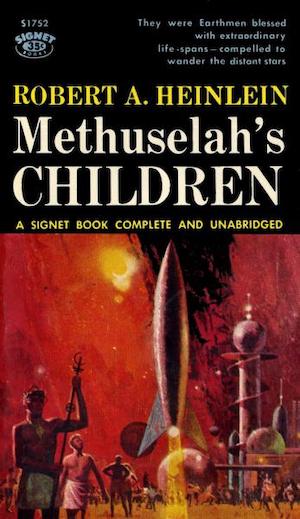
Products of an implausibly successful eugenics project, the long-lived Howard families become the focus of the mayfly masses’ paranoia that the Howards’ lifespan is not thanks to inherent genetic gifts but some secret they will not share. Life on Earth swiftly becomes untenable for the Howards. Those who can flee commandeer a sublight starship and flee to the stars, hoping to find a new world they can call home.
Earthlike worlds prove to be surprisingly common. There is however a small catch: the planet the Howards first encounter is already occupied. The alien Jockaira appear roughly comparable to humans. They are in fact property. The planet’s true masters are godlike, and they have no place for humans. An act of functionally divine will sends the Howards on their way… to a world whose gentle natives prove just as advanced in their way as the gods and even more disquieting to mortal humans.
Four-Day Planet by H. Beam Piper (1961)
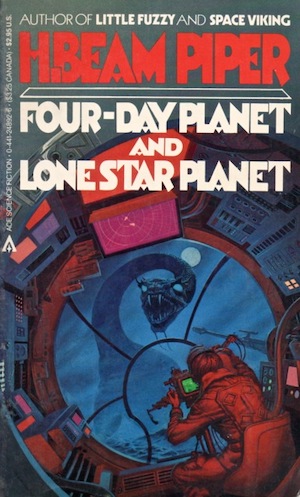
With the right air, the right gravity, a thriving biosphere, and a Sun-like star around which it orbits at the right distance, Fenris appears to qualify as a Class III Earthlike world, a planet unprotected humans can easily settle. Fenris’ day is the worm in this particular apple. Two thousand hours long, it guarantees extremes of temperature humans cannot survive without advanced, expensive technology.
At its peak, the planet had a quarter million people. Now it is down to ten thousand—those too poor or too stubborn to emigrate to Class III worlds. Fenris’ rudimentary economy depends on the export of tallow wax. However, exports are controlled by the Hunter’s Collective, and the Collective is in turn controlled by Steve Ravnick. Ravnick insists tallow wax prices are falling. Is Ravnick lying and pocketing undeclared profits? Unclear. What is clear is that Ravnick’s goons will do their best to kill anyone who asks that question.
We Who Are About To… by Joanna Russ (1977)
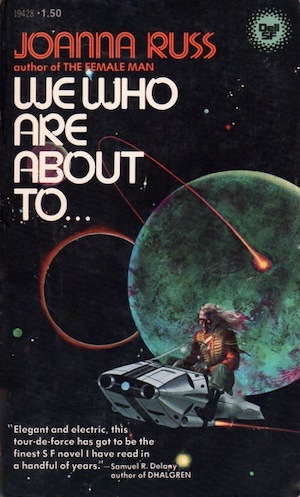
Mishaps in space tend to produce corpses in abundance. The eight survivors who find themselves on an empty, alien world appear to be extraordinarily fortunate exceptions. They did not die with their starship. While rescue can be ruled out, at least the world on which they will spend the rest of their lives is comparatively habitable.
Eight people equipped with meagre supplies retrieved from a dying starship cannot reasonably expect to colonize an unfamiliar world. Their numbers ensure inbreeding, their lack of equipment leaves them vulnerable to misfortune. The castaways have not so much survived as fallen victim to a more protracted form of death. Not that the certainty of failure deters some from resolving to trying to establish a thriving community in the name of preserving a human species that is flourishing…elsewhere.
The unnamed narrator has no desire to be some sort of castaway queen bee. Nor will she allow others to force her to comply. Pressing the point will prove, as her companions discover, quite fatal.
The Gates of Eden by Brian M. Stableford (1983)
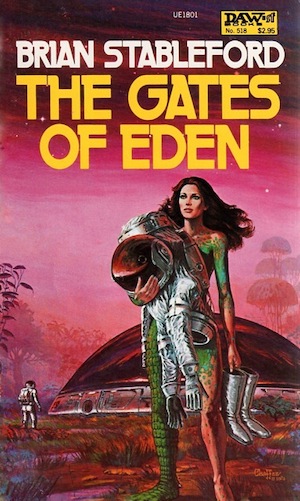
Faster than light travel comes with an insurmountable catch: hyperspace cannot be navigated without a hyperspace beacon at the destination. Such beacons can only be delivered at sublight speeds. By the 25th century, humanity knows of only a dozen life-bearing worlds, only two of which are habitable to humans, one of which is Earth and the other, Sule, is a world whose native civilization is equal to ours. Dreams of New Earth, empty and free for the taking, remain only dreams.
Now, however, a sublight probe proclaims Earth Three has been found. Even better, this pristine world has no cities, towns, or farms. There is no evidence that anything like Sule or Earth’s civilizations calls this world home. This is because, as unfortunate explorers will discover shortly before their painful demises, this world hosts something quite superior to their forms of life.
Black Sun Rising by C. S. Friedman (1991)
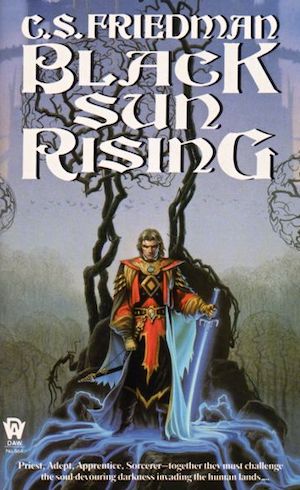
Despite incessant seismic activity, the planet Erna was too tempting to pass by. Earthlike worlds are rare. Frequent earthquakes are a small price to pay for a world on which humans can thrive without advanced life support equipment. As the first generation of colonists discovered to their considerable alarm, Erna has characteristics to which human technology is blind, characteristics that would have ruled out settling Erna.
Erna is home to the Fae, a mysterious force that transforms human whim into often horrifying reality. Mundane science and technology depend on nature’s predictable laws. Thanks to inherently unpredictably Fae, human technology swiftly regressed. Having lost the ability to flee Erna, the colonists’ distant descendants have no choice but to find some way to co-exist with the Fae or die trying.
No doubt there are far more recent examples of ill-fated colonization attempts, some of which are not Kim Stanley Robinson’s Aurora. Feel free to mention them in the comments!
In the words of Wikipedia editor TexasAndroid, prolific book reviewer and perennial Darwin Award nominee James Davis Nicoll is of “questionable notability.” His work has appeared in Publishers Weekly and Romantic Times as well as on his own websites, James Nicoll Reviews and the Aurora finalist Young People Read Old SFF (where he is assisted by editor Karen Lofstrom and web person Adrienne L. Travis). He is a four-time finalist for the Best Fan Writer Hugo Award and is surprisingly flammable.











I see what you did there.
Remnant Population by Elizabeth Moon. The colony where Ofelia has lived for 40 years is being closed down and the colonists shipped to other places. Except Ofelia isn’t going. She’ll be happy to live out her life alone on the planet. Except she’s not alone …
Surely you could have shown the even more ridiculously inaccurate UK cover for We Who Are About To … ?
:)
@@.-@: The cover art for the various editions of We Who Are About To… runs the full gamut from bizarre to risible.
Does C. J. Cherryh’s Forty Thousand in Gehenna count? They were supposed to be doomed, but …
There was a Poul Anderson story that had a doomed colony. The planet they were on was right on the edge of habitability on each of the {atmosphere, gravity, nutrient availability, etc} scales. Any one of those could be overcome, but all together meant slow death.
The colonists watched their numbers declining generation after generation. So they faked that they’d been attacked by aliens (unknown in the universe of that story) so that the powers that be would rescue them. Presumably TPTB were unmoved by the slowly declining populations and the pleas for help that must have been received and ignored.
Can’t remember its title, but it was explicitly modeled by what was then known about the Norse experience in Greenland.
I’m kind of surprised there’s no larry niven entries on this; the integral trees/smoke ring is a pretty interesting take on, if not doomed, certainly dysfunctional, colonies.
EDIT: And please ignore this comment! That’ll teach me to not read the last paragraph in an article before commenting…
It’s possibly more of a “colony ship” book than a “failed colonization” book, but I do think Aurora by Robinson would qualify here. The ending alone really gave me pause and made me remember that I need to appreciate Earth more than I do…
See also “The Crime and the Glory of Commander Suzdal” (1964) by Cordwainer Smith. The Earth colonists on Arachosia discover that the environment makes “femininity carcinogenic” so the surviving women undergo sex-change procedures to become male, with future reproduction through difficult artificial means. The story is problematic to many readers today because of its depictions of homosexuality and transsexuality.
H. M. Hoover’s Another Heaven, Another Earth. A 500 year old colony is slowly edging its way towards extinction after being cutoff from galactic civilization. In another 200 years, they’ll all be dead. Other aliens have settled this world before, but its toxins slowly changed and killed them over generations. The end is inevitable and may be inevitable for any humans who try to make a home on a world that isn’t their own.
Several Sydney Van Scyoc book deals with worlds that are, on some level, aware enough to recognize settlers as alien and to be torn between changing them or destroying them. The colonists, for their part, have to decide what price they’re willing to pay for survival.
In J. T. McIntosh’s “First Lady” (1952), initial colonisation is done by men; if the planet seems tolerable, one woman is delivered to become pregnant and see whether something ~unknown makes her deliver a monster instead of a human. The PoV is the couple responsible for getting the woman there; we learn after they’ve dropped off their charge (a dislikable airhead) that they know the odds are 90-10 against the planet being safe to breed on (and possibly that they’ve been in this position before) — but they know that without evidence the colonists won’t give up. Edmund Crispin, who was also known for his … conservative … attitude, chose this for his Best SF.
One of the Eric Frank Russell stories- the explorer had a parrot as a companion- had the protagonist discovering a world of sentient plants, and barely escaped with their lives. (Metamorphosite? Hobbyist?)
I recall a Golden Age novella about a planet that was terraformed with unexpected results. All of the arthropods and fungi are gargantuan, and humans are as gnats among them; they don’t even have a Stone Age culture, being just helpless victims of whatever wants to eat them today. The story follows a young man who discovers a way to the highlands, where the insects and fungi dwindle to their proper proportions, there are green plants, and dogs, despite not having seen a human being for untold generations, happily bound up to them and resume the old relationship. It’s complete fantasy and a gripping read. I just can’t remember the title or author.
Brunner’s “Polymath” doesn’t quite fit in this category – the humans split, and one group makes things worse for everyone/everything else. It’s up in the air whether the remaining colonists will survive, at the end of the story.
@12 The Hobbyist has the companion bird, but no sentient plants (rather a scarier single inhabitant). I’m not sure that anyone would want to colonize that world.
In fairness to Grampa Robert, the Howard Foundation isn’t exactly a eugenics program. It is a strictly-voluntary (though rewarded with cash) breeding program that does nothing to “eliminate undesirable traits”, the hallmark of a real eugenics program.
@13, are you thinking of this?
https://en.wikipedia.org/wiki/The_Forgotten_Planet
18 My suspicion is that the success of the project had nothing to do with Howard’s efforts and everything to do with Lazarus Long’s fondness for banging members of the early cohorts.
@16: That counts as eugenics.
@17: That’s it! The Forgotten Planet by Murray Leinster. Robust and vivid pulp!
John Brunner’s Total Eclipse ending.
I read it as a kid, and it left me depressed for weeks.
A couple of not-quite-failed colonies are Midworld and Pern. Minerva has a very thin crust and when the humans start throwing nucleonic bombs around and firing up various death rays all sorts of highly exciting things start happening.
Learning The World by Ken MacLeod features a generation ship coming across a a potential new system to settle, only to find it’s already occupied. (There’s a lot more going on than I can say without spoilering).
The title of the article doesn’t specify who is doing the colonising, so I suppose we could include War of the Worlds, and all the other alien invasion stories.
I have a copy of the anthology of that features the Poul Anderson story mentioned above (“The Alien Enemy”). The anthology is “The Queen of Air and Darkness” – which is the title of the opening story that features a Sherlock Holmes descendent who is the only consulting detective on a very fringe colony world, which faces a native species trying to coax the human invaders into “failing to thrive”.
Re: No 12 PamAdams
Perhaps you are thinking of “Symbiotica” There is a synopsis here;
https://variety-sf.blogspot.com/2007/09/eric-frank-russells-symbiotica.html
Adam Crowl:
“The Alien Enemy” – the title jogs my memory. I’m 95% certain that that was the story I half-remembered.
@25, I adore the adventures of the good ship Marathon and her determined but accident prone crew!
The Howard breeding program actually concentrates some bad genes. However, the disabled descendants are taken care of and protected, and a good thing, since some of them have psionic abilities which are essential for enabling the Howard families to escape Earth.
These are not novels but episodes of The Twilight Zone and The Outer Limits respectively: Thursday We Leave for Home; and The Mutant. Both deal with failed Earth colonies.
@15, @25,
Yes, I’m definitely mixing stories.
Stableford’s Daedalus Mission has a collection of failed/failing colonies. (And one successful in a creepy way.)
I might add a forthcoming story in Uncanny, Eugenia Triantafyllou’s “The Giants of the Violet Sea”, which turns on human colonies on two different planets, each struggling to survive.
(I get an advance copy, but it goes live at Uncanny on October 5.)
Grendel?
And a short story that i don’t think has been mentioned yet about the colonists who find excellent areas cleared for settlement beside the ocean which turn out every 70 years to be the breeding battle grounds of giant lobsters…..(there needs to be a shorthand for “Can’t remember title or author”)
Made me think of Sue Burke’s Semiosis and Interference. Love the sentient plants! Also Adrian Tchaikovsky’s Children of Time and Children of Ruin.
The Deathworld trilogy?
I always remember Heinlein’s Tunnel In the Sky for the shocking scene where a placid animal became a herd of ravenous beasts, the way locusts can emerge from grasshoppers. The young colonists were suddenly staring death in the face. I wrote a similar backstory for one of my cultures, where the mild planet they inhabited was suddenly overrun my monsters on a 200 year cycle.
Ok, but why the dig at this book? Making sure we know you know it and, rather than forgetting it, you did not put it on the list with malice aforethought. It probably is the best book in this sub-genre (pace Russ fans…). Certainly it’s in the top five!
I didn’t see requirement for written fiction only, so I’m throwing in the tropical paradise that is Acheron, formerly known as LV-426.
@5. I’d suggest Cherryh’s Serpents Reach might be a better example of a doomed colony, given that most of them get eaten
@33 – Purely inspired by your grendel comment – but that reminds me of Legacy of Heorot by Niven, Pournell and Barnes – though they were Samlon rather than Lobsters.
@21 You got there before me. Total Eclipse by Brunner has been, well, eclipsed by his more famous novels
@40, yeah, i’ve not made the connection with doomed colonization and legacy of heorot! I was going to comment, but never took the time!
Isaac Asimov’s horrific “Misbegotten Missionary”, a.k.a. “Green Patches” (1950) — after the green, furry patches that all the animals have in the place of eyes …
Before she ever met a Liaden, before Agent of Change, Miri Robertson’s mercenary company served on Klamath. A colony world being evacuated mid-war. Because the planet was somehow shaking itself apart.
Joan D. Vinge’s The Outcasts of Heaven Belt (1978) and the relates ‘Leacy” show a system that has become a dead-end due to loss of technology and an environment where tech is essential to survival. (no livable planet)
Hal Clement’s Ocean on Top shows an attempt to colonize the deep oceans of Earth that looks to be ultimately non-viable.